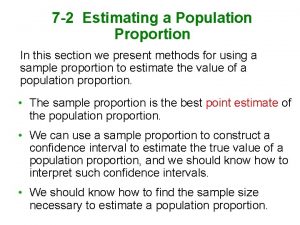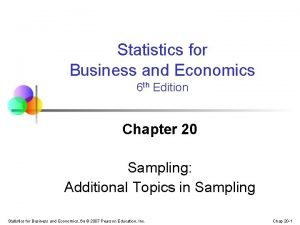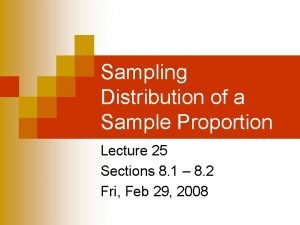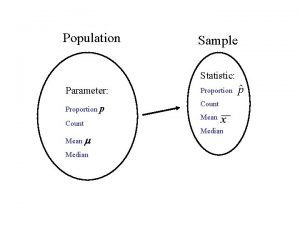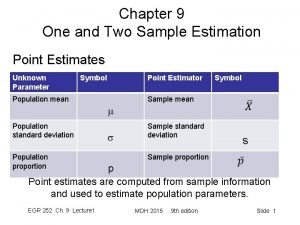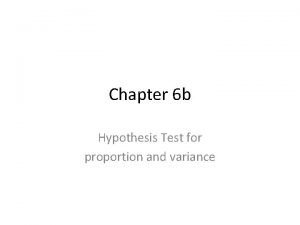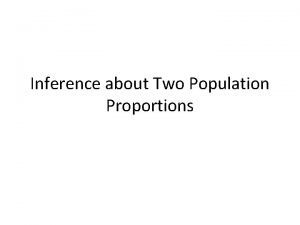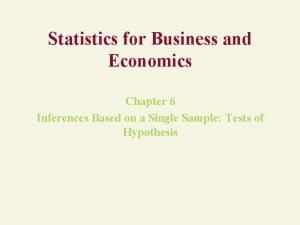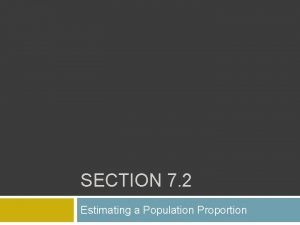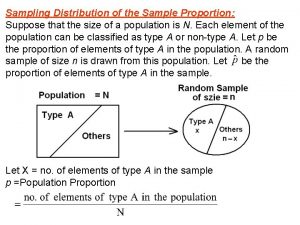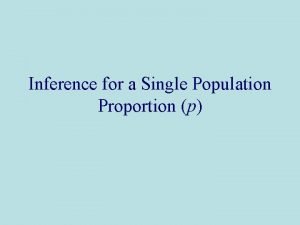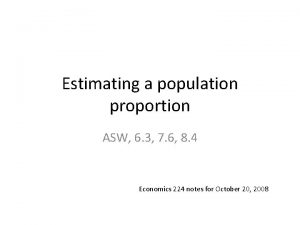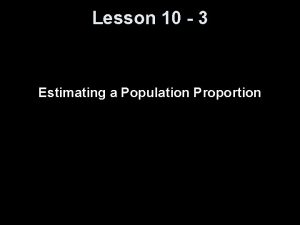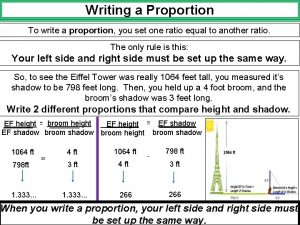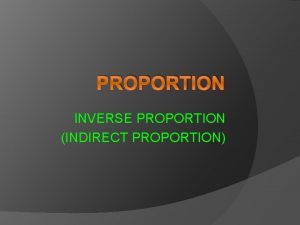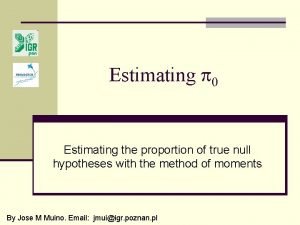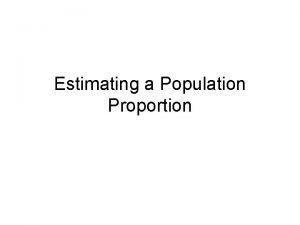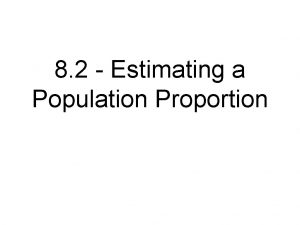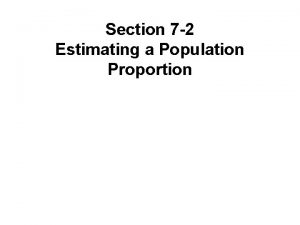ESTIMATING A POPULATION PROPORTION Proportion Review Important properties












- Slides: 12

ESTIMATING A POPULATION PROPORTION

Proportion Review Important properties of the sampling distribution of a sample proportion p-hat Center: The mean is p. That is, the sample proportion is an unbiased estimator of the population proportion p. Spread: The standard deviation of p-hat is √p(1 -p)/n, provided that the population is at least 10 times as large as the sample. Shape: If the sample size is large enough that both np and n(1 -p) are at least 10, the distribution of p-hat is approximately Normal.

Sampling Distribution of p-hat Approximately Normal if np ≥ 10 and n(1 -p)≥ 10

Inference Conditions for a Proportion Random – the data should come from a well designed random sample or randomized experiment Normality – for a confidence interval, n is large enough so that np and n(1 -p) are at least 10 or more Independence – individual observations are independent and when sampling without replacement, N > 10 n

Confidence Interval for proportions Always in form of PE MOE where MOE is confidence factor standard error of the estimate SE = √p(1 -p)/n and confidence factor is a z* value

Example 1 The Harvard School of Public Health did a survey of 10904 US college students and drinking habits. The researchers defined “frequent binge drinking” as having 5 or more drinks in a row three or more times in the past two weeks. According to this definition, 2486 students were classified as frequent binge drinkers. Based on these data, construct a 99% CI for the proportion p of all college students who admit to frequent binge drinking. State: true proportion of college students who are frequent binge drinkers p-hat = 2486 / 10904 = 0. 228

Example 1 cont Plan: One-sample z-interval 1) Random 2) Normality 3) Independence np = 2486>10 There are more than Assume n(1 -p)=8418>10 109, 040 college students Do: p-hat ± z* SE p-hat ± z* √p(1 -p)/n 0. 228 ± (2. 576) √(0. 228) (0. 772)/ 10904 0. 228 ± 0. 010 LB = 0. 218 < μ < 0. 238 = UB Conclude: With 99% confidence, we estimate the true proportion of college undergraduates who engage in frequent binge drinking lies between 21. 8 and 23. 8 %.

Example 2 We polled n = 500 voters and when asked about a ballot question, 47% of them were in favor. Obtain a 99% confidence interval for the population proportion in favor of this ballot question. State: p=true proportion of voters in favor of the ballot question Plan: one-sample z-interval 1) Random 2) Normality 3) Independence Selection np = 235>10 more than Assumed n(1 -p)=265>10 5, 000 voters

Example 2 cont We polled n = 500 voters and when asked about a ballot question, 47% of them were in favor. Obtain a 99% confidence interval for the population proportion in favor of this ballot question (α = 0. 005) Calculations: p-hat ± z* SE p-hat ± z* √p(1 -p)/n 0. 47 ± (2. 576) √(0. 47) (0. 53)/ 500 0. 47 ± 0. 05748 0. 41252 < p < 0. 52748 Interpretation: With 99% confidence, we estimate the true proportion of voters who favor the ballot question lies between 41. 3 and 52. 7 %.

Sample Size Needed for Estimating the Population Proportion p

Example 3 A company has received complaints about its customer service. The managers intend to hire a consultant to carry out a survey of customers. Before contacting the consultant, the company president wants some idea of the sample size that she will be required to pay for. One critical question is the degree of satisfaction with the company’s customer service, measured on a 5 -point scale. The president wants to estimate the proportion p of customers who are satisfied. She decides that she wants the estimate to be within 3% (0. 03) at a 95% confidence level. How large a sample is needed? 1067. 111 ≤ n Round up to 1068 respondents to ensure the margin of error is no more than 3%.

Confidence Intervals Form: Point Estimate (PE) Margin of Error (MOE) PE is an unbiased estimator of the population parameter MOE is confidence level standard error (SE) of the estimator SE is in the form of standard deviation / √sample size Specifics: MOE C-level Standard Error Parameter PE Number needed μ, with σ known x-bar z* σ / √n n = [z*σ/MOE]² μ, with σ unknown x-bar t* s / √n n = [z*σ/MOE]² p p-hat z* √p(1 -p)/n n = p(1 -p) [z*/MOE]² n = 0. 25[z*/MOE]²
 Estimating population proportion
Estimating population proportion What is proportional allocation
What is proportional allocation Population proportion symbol
Population proportion symbol Population proportion standard deviation
Population proportion standard deviation Population proportion symbol
Population proportion symbol Hypothesis testing for population proportion
Hypothesis testing for population proportion Population proportion definition
Population proportion definition What is the ha
What is the ha Population proportion
Population proportion Population proportion
Population proportion Population proportion
Population proportion Sample proportion
Sample proportion Section 1 population dynamics answer key
Section 1 population dynamics answer key
